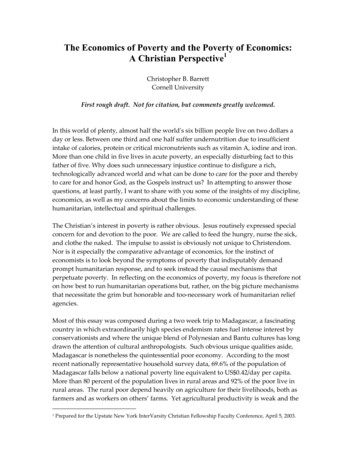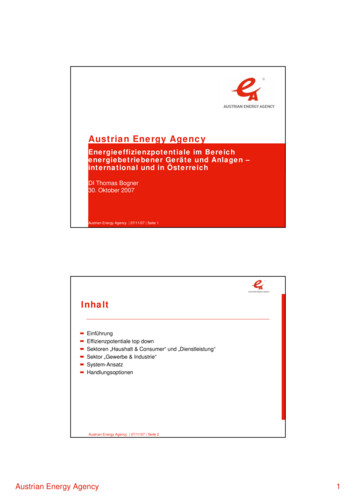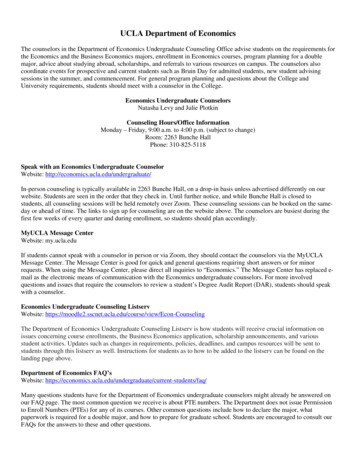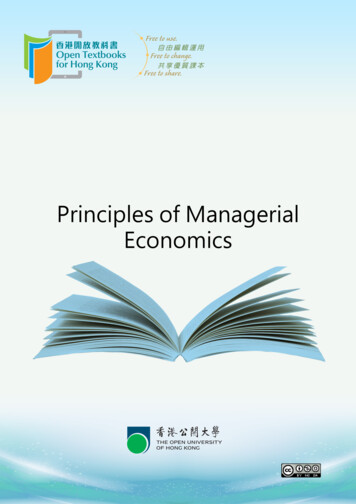
Transcription
Austrian Economics InContemporary BusinessApplications6 Professors build a robust bridge from economics toinnovative new business models.Think Better, Think Austrian
INTRODUCTIONEconomics for Business is a project to apply the insights ofAustrian economics to the business discipline.Business school instructors and business writers tend to view firms through thelenses of engineering and math. Firms and strategies are like engines or machines,to be designed and constructed and tuned. They operate on external variables likemarkets or structures like industries. Strategies are black boxes attached to theengines to boost performance.Austrian economics brings a new perspective and a new approach to thinking aboutstarting, growing and managing firms.Principles of Austrian economics, including, but not limited to, subjective value,consumer sovereignty, entrepreneurship, time preference, and capital theoryopen up pathways for innovative business thinking. These pathways penetratestrategy, finance, marketing, organizational design, and the broad swath of businessmanagement.Very importantly, Austrian economics is a science of human behavior. Customers,entrepreneurs, managers, and employees are seen as people, and not as automatonsor data series. Empathy is a core business skill. The purpose of business is to improvelives.We believe the Economics for Business project has thepotential for current educators (professors, businessschool instructors and others) to identify a path forthemselves as online instructors, course contentproducers, thought leaders, and valued experts in thenew field of Austrian Economics for Business.visit mises.org/e4b-creators to contribute2
CONTENTSThink Better, Think AustrianIntroduction .2Table of Contents .3Preface .4Chapter 1 by Steven E. PhelanThe Power of Austrian Subjectivism.12Chapter 2 by Matthew McCaffreyTeaching Austrian Economics throughProject Investment Appraisal.16Chapter 3 by Peter G. KleinEntrepreneurship Is Action Under Uncertainty.28Chapter 4 by Vishal K. GuptaCreativity, Ludwig Lachmann, and RadicalSubjectivism in Entrepreneurship.36Chapter 5 by Mark D. PackardTarget Areas For Austrian Advancement.41Chapter 6 by Per BylundMake Your Startup an Island.583
PREFACEProfessor Peter Klein observes that “The Austrian school is best-known for its fundamentalcontribution to economic theory. But Austrian economics is also eminently practical, witha wide range of applications to practical management problems”.This insight eventually developed into a project we call Economics For Business, a projectto greatly expand the awareness of Austrian economics and the appreciation of theapplicability of its theories and principles to business teaching and business consulting.The business discipline — business as taught in business school and at universities,and written about in business books — has inherited the same errors of positivism ashas economics and psychology. All variables are viewed as measurable, and so can bemathematicized and isolated in experiments. People are automatons and their behaviorcan be motivated and manipulated. There is a positivist agenda and a deterministicparadigm, and the goal is to predict.Austrianism offers a totally different paradigm, with the aim to understand rather thanto predict. We can offer concepts of how we think the world works, and these conceptsare studiable. There is plenty of room for empirical data, but the conclusions are softer(as opposed to “this is true”), tending towards indications of how to continuously anddynamically adapt to changes, and towards improved chances of better serving customersby better understanding them.Such a change in the science of business would be a Kuhnian paradigm shift. There is noshortage of building blocks from which we can construct a new science of business.4
CustomerSovereigntyThe proper terminology in Austrianeconomics is consumer sovereignty,indicating the power exerted byconsumers over the production processby buying or not buying. In ServiceScience, the branch of the businessdiscipline that studies service systems ofproduction and delivery and feedback(as opposed to manufacturing andphysical goods), the term for the end-user is always customer, whether theservice is B2C or B2B. We can adoptthe customer terminology because theprinciples of empathic diagnosis toidentify and understand wants and needsis applicable to consumers of economicgoods as well as customers of businessservices.As a result of seeing through the lensof customer sovereignty and deducingcustomer motivations and preferencesthrough empathic diagnosis, Austrianeconomics brings a revolutionaryapproach to business strategy, and newmeaning to the concept of customercentricity. A business concept like Agile,which purports to place the customerat the earliest possible position in thestages of production, is given new clarity.Subjective ValueThe purpose of business is to createand keep customers, according to PeterDrucker (who, incidentally, is Austrianby birth and met economists like Ludwig5“The purpose ofbusiness is to createand keep customers.”von Mises and Joseph Schumpeter at thefamily dinner table in Vienna). Drucker’sproposed primary route is the creation ofvalue through innovation and marketing.Austrian economists know about andunderstand value better than anyoneelse in the business discipline. Value issubjective — an experience that takesplace entirely in the customer domain.Logically, no external force can createit or even co-create it. Only those whoultimately consume can create value.Value is not “created” by firms.This insight places Austrian economistsin the unique position of redefining valuefor business practitioners and redefiningthe purpose and processes of the firm.
Entrepreneurial JudgmentAustrian economics identifies the entrepreneur as the driver of the market system.Entrepreneurship is the process of identifying unmet customer needs, imagininga new solution to meet those needs, assembling the resources to activate the newsolution and offering a value proposition to the customer.This process is conducted in uncertainty — there is value uncertainty on the partof the customer, who can’t possibly know if a future value experience will besatisfactory, and on the part of the producer, who can’t possibly know whether thevalue proposition will be well-received.Entrepreneurial judgment cuts through uncertainty as an act of will. Theentrepreneur seeks to reduce the magnitude of the uncertainty — an effort withwhich Austrian economists are best placed to help — but nevertheless mustultimately act in its continued presence and assess the outcome of the action.Austrian economists have studied entrepreneurial judgment, including how it isdelegated and distributed in firms and economic ecosystems. We therefore havemuch to say about innovation, organizational design, partnerships, contractualarrangements, and all the aspects of business where acting under uncertainty is thenorm.6
Capital AllocationAustrian Capital Theory is the best intellectual tool for the allocation of scarce capitalin the context of the firm. It can be utilized to identify those parts of the capital stockthat generate the highest return in terms of revenue from customers. Often this is asmall percentage of a firm’s capital — much of the rest is essentially overhead or cost— and the clarity of Austrian analysis is particularly helpful to businesspeople.Austrian Capital Theory also points the way to a required flexibility in the capitalstructure of the firm — it should rapidly reflect changes in the market data — andsuggests highly contemporary approaches to capital where “fixed” is replaced by“flexible” in new-to-the-world supply chain (or supply network) arrangements.Application to the Business DisciplineThree examples of elements of the business discipline that Austrianism wouldchange in this paradigm shift are marketing, organizational design, and businessstrategy.7
MarketingThis is the business discipline that isclosest to subjective value and hasmade strides towards Austrianism withconcepts such as service-dominant logic(which Hanken School scholars haveadvanced to customer-dominant logicand Austrians can advance further tovalue-dominant logic).However, marketing today is in the gripof so-called behavioral economics toexplain consumer behavior (as opposedto Austrian subjective value). Behavioralecon suffers from the aim to predict andto manipulate consumer behavior basedon the results of experimental findings.An Austrian approach to marketingwould focus on understanding consumerends and desires, and on facilitating theirexperience (as opposed to, for example,“persuading” them to buy). Facilitationmight result in consumers re-orderingtheir preferences as an emergent resultof two-way interaction with them.Marketing’s role is both to help theconsumer to learn (the Value LearningProcess) and to learn from themin return. The marketing goal is tounderstand what the consumer’s life islike, and to learn how to fit in to it andcontribute to better experiences.Marketing would not be a function or adepartment in a firm, but an integratedunderstanding within all part of a firm’sstructure, especially those that haveinteraction with customers.8“An Austrianapproach tomarketingwould focus onunderstandingconsumer endsand desires, andon facilitatingtheir experience(as opposed to,for example,“persuading” themto buy).”Empathic accuracy would be marketing’scurrency. Design and communicationwould follow.
Organizational DesignAustrians are already major contributors to organizational design thinking, mostly onsubjects regarding the best alignment of incentives, the structure of hierarchy versusnetwork, and the role of judgment, both original and derived.An Austrian organizational design paradigm would focus on the value propositionand how to deliver it. Since value propositions should be unique, then organizationaldesigns are not replicable.An Austrian theory of organizational design would focus on how to bring marketsinto the interior of the organization, and on the (subjective) individual motivations ofemployees.How can those ends be aligned with those of the organization’s owners? How canthe firm best hire people with aligned ends? How can the firm align with individuals’purpose in their work, and help them see and understand how the firm’s purposefits them? How can organizational design best be matched to the firm’s mission andbusiness model?The firm is a facilitator of value for its “members” (customers and employees) but not“stakeholders” (e.g. shareholders, environmental activists).9
Business StrategyAustrianism is probably viewed as closest to the Resource Based View (RBV) ofstrategy at the firm level, but this view may need rescuing, at best, or replacing.In RBV, resources are said to have value — meaning in the objective sense, assessedby VRIO (Value, Rarity, Imitability, Organization). An Austrian view would seeresources subjectively: resources are a concept. Resources can not constitute a“competitive advantage”.The only competitive advantage is that consumers prefer one value proposition toanother at one point in time.Similarly, strategic frameworks like Porter’s 5 Forces and P&G’s Where To Play AndHow To Win have no place in Austrianism. The idea of an “industry” (core to Porter’smodel) is a made-up concept without validity.A breakthrough for Austrianism would be to develop a toolset that consultants coulduse to help clients (which is at the core of what we are trying to do with the E4Bproject).10
SummaryWe envisage a “movement” among the Austrian community to pursue thisAustrianization of the business discipline. In addition to advancing Austrianeconomics, it would provide productive pathways for young Austrian economists inbusiness schools, consultancies and business in general.In this collection, we present the individual thoughts — and some personalexperiences — of six professors on the general subject of the application of Austrianeconomics to business. Our purpose is to stimulate enthusiasm among the broadbase of Austrian economists and Austrian-friendly and Austrian-aligned businessthinkers.We are building the knowledge management capability of the Economics forBusiness project. This will include content, teaching (in the form of online courses),tools, forums, experience sharing and mentoring. We hope to encourage thecommunity of Austrian economists to contribute, and make a name for themselves inthe newly shifted business discipline paradigm.Please feel free to contact any one of the contributors whose works are featured inthis book, or register at mises.org/e4b-creators to learn more about the Economicsfor Business project.11
CHAPTER 1THE POWER OFAUSTRIAN SUBJECTIVISMSteven E. Phelan, Distinguished Professor ofEntrepreneurship at Fayetteville State UniversityI have been an academic for over 25years. But before ascending to the ivorytower, I worked for several years at largecorporations in strategy and finance.Both strategy and finance deal with thefuture.One of my jobs involved managing thefinancial projections for the first opticalfiber network in Australia. Another, thepurchase and disposition of jets forAustralia’s largest private airline. Bothprojects required heroic assumptionsabout revenue, expenses, and capitalinvestment for 20 years into the future.In fact, capital budgeting techniquestake for granted that you can projectthe risk-adjusted cashflows for a projectin perpetuity, consider the incrementaleffects of different scenarios, and selectthe course of action that will maximizediscounted expected cash flow.The logic is impeccable, the mathexquisite — as long as the assumptionshold.Steven E. PhelanDistinguished Professor ofEntrepreneurship at FayettevilleState ephelan/@drstevenphelan12
The problem, particularly with the optical fiber network, was that the numbersdidn’t work. In every scenario that used realistic inputs, the value of the projectwas negative. As a quant — a non-business major with a penchant for numbers — Ithought this was quaint, but I had no idea what I was doing wrong. In the end, I wasable to torture the numbers to produce a positive return and the network was built.In truth, it was going to be built anyway, but the ‘good’ numbers were still neededfor some sort of totemic reassurance. Much later, I discovered something called realoptions theory, and realized I’d been leaving out a great deal of value in my project,enough to easily make the project feasible. But calculating the option value of theproject required even more math and heroic assumptions. Early in my career, I wouldchannel this frustration into a 1997 paper titled ‘The illusion of certainty in capitalbudgeting’.At the heart of the math, is an assumption that we know the distribution of futurecashflows. In financial markets, these distributions are estimated with historical data.But what if there is no history?As the first optical fiber network, we had no precedent for how customers wouldreact. Our research team proved helpful, supplying us with different diffusion curvesfor earlier technologies, but choosing the right curve was an art, not a science.My paper commented on the need to complement quantitative analysis withqualitative judgment, not realizing I had just re-discovered what Ludwig von Miseshad been telling us almost fifty years earlier!13
One little anecdote that illustrates thispoint is a time when several managerswere debating whether to install opticalfiber into new housing developments.This was the tipping point for thetechnology and copper was still cheaperthan fiber. The engineers were instructedto lay copper wires to maximize profit.Several years later, the same seniormanagers were bemoaning the factthat they would have to replace all thecopper wire with fiber at great expense.“Never mind”, said the senior engineer,“we installed fiber anyway, because wethought the previous decision was sostupid!”Arguably, the engineers were ableto see value beyond the immediatecosts and acted accordingly (albeitinsubordinately).Austrian economics provides severalsalutary lessons for business technocrats(aka MBA students). For much of theirprogram, they are taught the machineryof analysis, as if assumptions werecertainties rather than approximations.Jay Barney, a well-known scholarof strategic management, used toargue that the key contributionof entrepreneurship to businessschools was exposing students to the‘management of uncertainty’.A similar claim could be made aboutAustrian economics. Exposing studentsto Austrian ideas about the marketprocess reminds them that the numbersin the Harvard case studies they routinelycrunch are not givens, but rather the14subjective impressions of some analystor decision maker.As such, competition is a discoveryprocess that tests the relative strength ofeach player’s beliefs about the future.Each owner must make a (subjective)judgment about how the future willunfold and deploy resources according tothat vision.The more uncertain the future, the morehedging is required to mitigate againstunforeseen events.Flexibility becomes valuable, certaintyis a liability. From this insight flows theadvice to startups to experiment withbold conjectures but not risk more thancan be lost.The advice is equally applicable tomature businesses seeking to innovate.
We need to encourage business students to come out from behind the numbers intothe real world and discard the notion that production can be optimized via linearprogramming, simultaneous equations, or, god forbid, calculus.The world is a dynamic place, much of it uncertain, and not amenable to techniquesthat assume regularity. Every decade, managers routinely describe their own ageas more turbulent than the one before, forgetting the difficulties of a previousgeneration.However, as Nassim Taleb reminds us, ‘black swan’ events have been an omnipresentaspect of human existence. What managers are really bemoaning is that their modelsdon’t work.One of the biggest complaints from employers of MBA students is that they are greatat solving structured problems but poor at working on unstructured problems, thatis, problems where the objectives, options, and payoffs are not immediately obvious.Teaching our students to view decisions from an Austrian perspective can only boosttheir ability to work on the most complex problems that managers face. In hindsight,my employer made a good decision to build an optical fiber network, even thoughthe rationale for doing so was poor.Ultimately, someone at the top weighed the evidence and made the call in spite of,not because of, the hard data. That was a good thing.15
CHAPTER 2TEACHING AUSTRIANECONOMICS THROUGH PROJECTINVESTMENT APPRAISALMatthew McCaffrey, Assistant Professor of Enterpriseat the University of ManchesterAustrian economists stress theimportance of realism in economictheory, so it should come as nosurprise that the same concern figuresprominently in their economics teachingas well.In fact, Austrians’ emphasis on realismis one reason their ideas have provedvaluable in business schools, whereasmany ideas from mainstream economicshave not; like Austrian economics,management teaching and researchalso tend to revolve around real-worldproblems facing entrepreneurs andmanagers, so it is understandable thatthey would have significant commonground.Within management education andpedagogy, entrepreneurship educationin particular stresses realistic, practical,and hands-on methods. A potentialexample is the process of projectinvestment appraisal, which can givestudents insight into the everydayproblems of business planning, cashflow, and numerous other aspects of theentrepreneurial journey.16Matthew McCaffreyAssistant Professor of Enterprise atthe University of in.com/in/matthew-c-mccaffrey@libertarianpprs
And precisely because it can account for real, applied problems, project investmentappraisal also offers windows into many central themes of Austrian economics,especially the theories of production and entrepreneurship.Below I explain a number of these connections, drawing on my experience teachinga course on Investment Economics and Innovation to business students. I approachthis topic specifically in light of project investments. Projects can take many forms,but in my class, the discussion focuses on founding a new enterprise or expanding anestablished one.The emphasis is on investments into “real” projects like new businesses that excludepurely financial investments, though it should be noted that the principles discussedare also relevant for pricing financial assets. Furthermore, as mentioned below, realproject appraisal also sheds light on some special problems facing non-traditionalbusiness organizations, especially publicly-owned or publicly-run ventures.In what follows, investment appraisal refers mainly to cash flow analysis. It involvesforecasting the costs and revenues of a project, evaluating the resulting cash flowsusing a selection of investment indicators, and subjecting the cash flows andindicators to a variety of sensitivity tests.The relevant material tends to be covered in most investing or corporate financetextbooks. In practice, appraisal is carried out through spreadsheet modeling of theenterprise’s finances over time. The purpose of this process is to decide whether abusiness is investible or not, and if so, under what conditions.It can be done simply for the entrepreneur’s own benefit, or as the basis of aninvestment pitch.17
It is vital to point out that this processis uncertain and that entrepreneurs,like all human beings, are prone toerror. Some events simply cannot beforeseen or forecast accurately, andproject investment appraisal doesnot automatically create successfulentrepreneurs.Nevertheless, it is a valuable toolfor business planning that can teaseout many subtle implications ofentrepreneurs’ decisions, and it givesa more concrete shape to their plansfor the business. It highlights how theprocess of valuation and capitalizationexplained in Austrian economic theoryplays out in real-world enterprises, andhow it can be represented in part bysome commonly used financial tools.Project investment appraisal thus helpsentrepreneurs recognize some of thechallenges they face, many of which canbe more clearly understood by usingAustrian insights into entrepreneurshipand the production process.Of course, investment appraisal is notthe only context in which these kinds ofpoints can be made to business students;however, it can be a particularly effectiveone, especially when students constructtheir own investment models andforecast their own cash flows.“Austrians’ emphasison realism isone reason theirideas have provedvaluable in businessschools, whereasmany ideas frommainstreameconomics have not.Below I explain some examplesof Austrian ideas that investmentappraisal can draw upon, includingeconomic calculation, moneyThis kind of assignment confronts themprices, entrepreneurial judgment,with a practical problem and allows themvalue imputation, factor pricing,to apply a variety of Austrian economictime preference, and the effects ofconcepts to solve it.intervention.18”
Appraisal and Economic CalculationThe theory of economic calculation is a vital component of Austrian economics. In amarket economy, calculation is the means by which entrepreneurs choose betweena vast number of potential production methods and rationally allocate resources inorder to meet the most urgent needs of consumers.It is, at its heart, a problem of entrepreneurs appraising future prices: entrepreneursuse judgment to anticipate prices in order to calculate costs and plan production inthe present to satisfy consumer wants in the future, all while earning a profit. Thereare several connections between calculation and project investment appraisal thatare worth exploring.In a sense, project investment appraisal is simply economic calculation on a small,practical scale. Outlining the expected costs, revenues, and cash flows of a businessrequires a common denominator in which to express these values. That commondenominator is money prices. Without prices, there is no way to compare theenormous array of possible combinations of factors of production used as inputs,much less compare them to outputs. A common unit is therefore a vital preconditionof economic calculation.And it is easy for students to see why these money prices are necessary: withoutthem, a cash flow model simply becomes a massive list of apples and oranges, withno way to compare. By attaching monetary values to the factors of production, itbecomes possible to estimate both their true costs and their contributions to thevalue of the business.19
Yet there is a subtler point to be made as well: students are also quick to grasp thatthe prices they use in their cash flow models must mean something. If they areinaccurate or arbitrary, then any cost and revenue estimates based on them areuseless as well. Real-world entrepreneurs cannot “play market” by inventing pricedata any more than central economic planning committees can.This leads to another insight that is brought to life by investment appraisal: studentscan easily understand that for public projects and enterprises there are often no costsor revenues to input, or any meaningful cash flows to appraise.For example, public enterprises may use price controls to pay artificially low pricesfor land, labor, and capital, or public goods may be provided at zero price at the pointof consumption. These kinds of operations leave enormous gaps in any investmentanalysis. Of course, data can always be estimated or invented, but it is easy to seehow doing so undermines the realism and the usefulness of the appraisal process.It also hints that the projects themselves face serious calculation problems, as theyhave little or no way to measure their own success. Students thus see the uselessnessof inventing prices to include in a cash flow model: as the old saying goes, “garbagein, garbage out.” In this sense, working through a project appraisal also promotes akind of realism that is sadly lacking in much business-school teaching.Standard classroom exercises in environmental scanning and strategy, for instance,often give a simplistic view of the complexity and uncertainty of entrepreneurship,encouraging students to think in terms of applying basic data to find convenient,one-size-fits-all solutions to fit pre-packaged case-study problems.20
In contrast, students trying to forecast using incomplete data learn quickly thatproject investment appraisal is a speculative and fundamentally uncertain process:it can be nearly impossible to manage, even at the small scale at which most studentbusiness ideas operate.“Calculation is the means by whichentrepreneurs choose between a vast numberof potential production methods and rationallyallocate resources in order to meet the mosturgent needs of consumers.”Although there may be reliable data available regarding current costs, prices, andother quantitative factors used in cash flow analysis, the data of the market are oftenunknown and constantly changing, and in entrepreneurship the only constant isuncertainty.As a result, entrepreneurs are obliged to forecast changes in the data. Yet doing thisin practice immediately reveals how limited historical market data are for planning.Entrepreneurs must appraise the future prices of the factors of production, whichcannot be done simply by projecting past prices forward in time.This is a key lesson for my students, and one that is made clearer using the theory ofeconomic calculation.21
Production, Imputation, andNet Present ValueThis economic process gives students another way to look at project investmentappraisal, in which Net Present Value (NPV) plays a key role. Specifically, Austrianvalue theory helps to show students that the appraisal process, including the use ofquantitative indicators like NPV, is consumer-driven.The unique core of Austrian economics is its theory of value, price, and distribution.Austrian theory provides a unified account of value and price that shows howconsumer valuations determine the entire system of market prices.All prices ultimately trace back to individual preferences: the factors of production,land, labor, and capital goods, possess value because they create value for theconsumers of final goods. The value of final consumer goods is imputed to the goodsused to produce them. In fact, the market price of a factor of production is simply thetotal income it is expected to generate over its life, discounted for time preference.The process of anticipating the future income produced by a factor, and assigning it apresent price, is called capitalization. The final discounted price is called Net PresentValue. NPV is the present monetary value of all future cash flows, taking into accountthe time-value of money (applied through a discount rate).In investing, NPV is usually calculated for a business as a whole: it is the sum of theenterprise’s individual capital values.22
Appraising a business requires planningwhich factors to combine, how tocombine them, and the money cost ofthe combination. Cost estimates are thensubtracted from revenue estimates t
INTRODUCTION Economics for Business is a project to apply the insights of Austrian economics to the business discipline. . suggests highly contemporary approaches to capital where “fixed” is replaced by “flexible” in new-to-the










